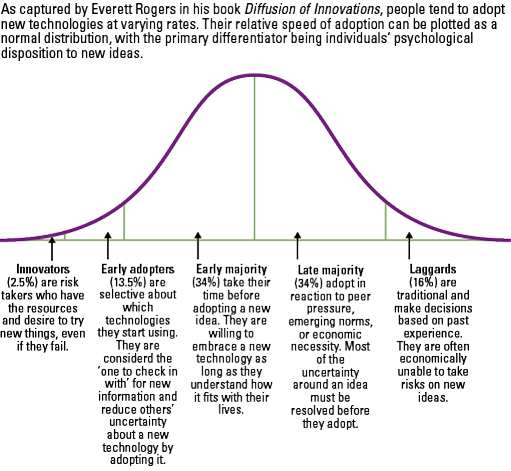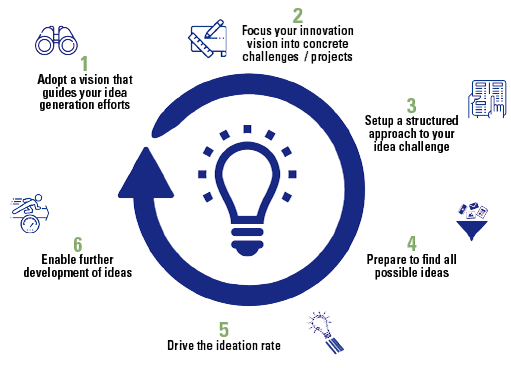Crowdsourced idea generation can bridge the gap between stimulating internal innovation capabilities of organizations and identifying the industry’s future disruptors. KPMG’s Innovation Factory, which is part of the Smart Tech solutions portfolio, is an industry leader in cloud-based ideation software. Building on the extensive experience KPMG has using this Smart Tech solution in both internal and external ideation challenges, we give examples of how crowd-sourced ideation can help organizations find long-term organizational success by developing and implementing new ideas.
Introduction
According to [MITS17-1]: ‘approximately 50% of U.S. annual GDP growth can be attributed to product and service innovation, and more than 90% of executives claim that long-term organizational success depends on developing and implementing new ideas.’ Additionally, another study in the same journal [MITS17-2] reported a significant correlation between the ideation rate at companies and the growth in profit or net income: the more ideation, the faster they grew. The challenge lies in finding those now ideas!
Building on these statistics, it seems more than logical that companies should be spending their time and resources finding and developing ideas to fuel growth. But where a lot of organizations nowadays tend to focus on identifying the future disruptors of their industry, a lot of uncut diamonds of knowledge within their own organization are still waiting to be discovered. Many companies have extensive experience in working with start-ups, starting investment funds or organizing hackathons, but forget to stimulate the internal innovation capabilities of their own organization. Additionally, many senior executives are trained as operators, not innovators, and tend to focus on activities that contribute to exploitation rather than exploration. According to data from 3.5 million employees analyzed by [HABR17-1], crowdsourced ideation, when properly executed, can bridge this gap. It is a great way of generating new ideas and using the knowledge and creativity of your organization, while building innovation capabilities among your employees.
The benefits and challenges of crowd-sourced ideation
Example
That the benefits of crowdsourcing can be staggering is illustrated by Deutsche Post [DHL09], which announced in 2009 that employee inventiveness through idea management resulted in benefits of € 265 million. In other words, this resulted in a financial benefit due to crowdsourcing of € 530 per employee. In similar fashion, Continental [CONT16] announced in 2016 that employees saved around € 550 million over the last four years through Continental Idea Management – saving approximately € 124 million in 2015, or € 596 per employee.
So, why do so many companies leave all that knowledge within their direct ecosystem unused and sometimes even uncharted? Well, because it is a complex process. In our client engagements we often meet sceptical employees, who see crowd-sourcing as just another black box for ideas. They believe that, after submitting an idea, they will not hear about it again, will not be included in the feedback loop or be part of implementation afterwards. Sometimes, this can be caused by a risk averse organization, which leaves innovative ideas unrewarded – or even actively discourages new ideas. Other times a process to find and improve the best ideas, and to later implement them, is simply lacking. All of this can kill employee participation in the blink of an eye; nothing is more discouraging than working on new ideas, only to see that none are picked up for further development and implementation.
A path towards reaping the benefits, and avoiding the challenges of crowdsourced ideation
In order to streamline crowdsourcing in your organization, and enable the wealth of ideas to flourish, we have identified a couple of best practices.
1. Adopt a vision that guides your idea generation efforts
Idea generation starts with a shared vision on innovation and defining focus areas. A great example of this approach is Imagine Chemistry by AkzoNobel Specialty Chemicals [ICAN18]. During the past two years, they have organized an open innovation program, challenging start-ups to work with them. AkzoNobel Specialty Chemicals started with defining key focus areas, in which they have identified opportunities. This guides the program, allows experts to contribute and enables a targeted approach to which start-ups can connect. The key is to have a shared understanding of the goals of crowdsourcing, and top management support for both the vision and the focus areas. As each day could hold unexpected changes in technology, regulations and customer preferences, even the best run organizations can become obsolete. By focusing too many resources on exploiting existing business, you run the risk of getting better and better at things your customers might some day care less about. The key is to explore new products, services and even business models to stay relevant. Consider spending resources on new initiatives that do not always have defined revenue or profit goals, because their purpose is to explore opportunities that cannot yet be quantified. Crowdsourcing is a great way to involve the whole company in generating ideas that kick start those new initiatives.
2. Focus your innovation vision into concrete challenges and projects
Once you have a shared vision, make sure to translate that vision into concrete challenges for the crowd (your employees). Be clear which (client) problem you want to solve, and make sure your selection criteria reflect the direction of the type of solutions you are looking for, without limiting the scope of potential ideas. As an innovation team at KPMG, we have extensive experience in running idea challenges, and are never disappointed by the number of ideas. However, sometimes a portion of the generated ideas does not appear to solve the actual problem. Often, this is because selection criteria were not well communicated; or because management was not clear on the expectations for the output. Be transparent about your expectations and assessment of the submitted ideas from the beginning.
3. Setup a structured approach to your idea challenge
To leverage the wealth of internal ideas in an effective manner, thereby linking ideation to strategic focus areas and the innovation portfolio, organizations should implement idea management in a structured manner. A recent study from [IJIS17] found that companies that embraced a program aimed at idea management have more successful innovation behavior. Examples of integral idea management are setting up an agile stage gate process and managing your idea portfolio while keeping a mix of Horizon 1, 2 and 3 innovations in mind.
4. Prepare to find all possible ideas
Almost by definition, disruptive ideas will not address the masses, at least not initially. Evaluating and selecting ideas by looking primarily at current market demand will therefore often result in excluding more disruptive ideas. As the technology adoption curve shows, new ideas are typically not well understood, and tend to perform rather weakly during the first couple of years. The curve shows that, for new products, innovators and early adopters combined account for only 16% market share. While some ideation challenges will be aimed at generating short term benefits, balance the focus areas to also delve into the more challenging or difficult areas. Additionally, our advice to all organizations is to have a process in place that can distinguish more disruptive ideas, and stimulates development of both incremental and more radical ideas. Evaluating and selecting ideas based purely on market size or revenue in the next five years may not be the best approach. Instead, include softer metrics, such as the wow-factor and customer experience (enhancements), into your selection process to uncover hidden gems.
Figure 1. The Technology Adoption Curve. [Click on the image for a larger image]
5. Drive the ideation rate
Once management is on board and committed to innovating through crowdsourcing, it is crucial to focus on impact. Innovation is, like marketing and sales, a pipeline. Through crowdsourcing, you can fill up one end of the funnel, to make sure that financial benefits for your organization keep emerging from the other end. But how do you keep this funnel filled up? By keeping the ideation rate high. The ideation rate is the number of ideas approved by management, divided by the total number of active participants in crowdsourcing. Studies in [HABR17-2] and [MITS17-1] show us that whether your company is aiming for incremental or disruptive innovations, the variables to boost the ideation rate are the same. These variables consist of four key factors, which should therefore be included and steered on in every idea management program, as focusing on these factors will keep the ideation rate high.
Aim for scale
Engage as many participants as possible, as a large group of people will always generate more ideas than a small group of people. As a benchmark, the [HABR17-2] study shows us that on average every four participants to an idea management system, generate one idea. In our experience, it is of the utmost importance to execute an integral communication plan that targets all the members of the crowd.
Raise the frequency
Organizing more idea challenges will lead to more ideas, and a fuller innovation funnel. It will also get employees used to crowdsourcing ideation and innovation, and a culture of innovation will take hold. We recommend clients to organize at least one full-scale challenge each year to engage the whole of the company, preferably accompanied by multiple smaller, more focused idea challenges on different topics and with smaller crowds.
Engage the crowd
We like to use the analogy of a greenhouse, in which seeds are sown and nurtured until they grow into full concepts that are ready to be harvested. Comments, likes, and discussions are fuel for the ideas to grow. It enables ideas to get better and more people to have a grasp of the potential value of the ideas. Forget about the static idea box, online dialogues that turn raw concepts into good ideas are the engine of crowdsourcing.
Different perspectives
Engaging not only subject matter experts, but a more diverse crowd, will lead to better ideas. Tap into their expertise early in the ideation phase. Where relevant expertise helps to gain new insights and another perspective, the network is crucial for both idea generation and innovation acceptance. Especially staff that is close to the front line, such as shop associates and call center employees, can shed a very different light on ideas submitted. They tend to have a different understanding of your clients, the work to be done and the challenges faced in day to day operations. We also advise clients to consider engaging their external ecosystem, to enrich ideas with outside expertise. Leveraging your network will help you come up with better ideas. In the Imagine Chemistry competition of AkzoNobel [ICAN18], participating start-ups had access to the expertise of chemical specialists. This considerably accelerated the development of the innovative solutions, inspired the AkzoNobel specialists, and created an alternative innovation funnel (next to the traditional R&D pipeline).
6. Enable further development of ideas
Making sure the ideation rate is high, is not the only key to the successful crowdsourcing of ideas. It is also about uncovering entrepreneurial pockets within the ecosystem, and unleashing these through creating adaptive space; a great concept recently coined in the abovementioned study of [MITS17-1]. Adaptive space is defined as the network and organizational context that allows people, ideas, information and resources to flow across the organization. As innovation is fuelled to a large extent by the transfer of knowledge, adaptive space is a critical factor in making innovation work. Until now we have been discussing the tools to focus all stakeholders on certain topics, and to increase the number and quality of ideas. The next step is to dive into the manner in which these ideas will spread across the organization or ecosystem. As the spreading of knowledge and ideas is based on interaction, this should be stimulated by creating three psychological benefits for participants.
Establish mutual benefits for the crowd
Crowdsourcing is not a zero-sum game, so engage with others in a way that benefits them, as well as you. For instance, in a recent engagement, we supported a client that was explicitly looking for innovative solutions, that would benefit their customers as well as their employees. The participation rate was significantly higher than the benchmark.
Spread ownership of the idea
So-called hub-and-spoke models of innovation, where idea submitters put themselves in the centre of interaction, and coordinate all efforts have been shown to be less effective, as all iterations and feedback have to pass through a single person. This often results in a decrease in discussion and group interaction, hampering the wisdom of the crowd. Additionally, a potential drawback is that the hub – the idea submitter – is opinionated about his or her idea, and could filter out suggestions which might be good, but are not in line with the original idea. As stated earlier, engage with the right expertise, share ownership and work on an idea together. This will increase the dialogue and help create a shared vision. We advise our clients to not only reward the submitter of the best idea, but also the top collaborators; improving an idea is as important as coming up with the initial idea.
Create trust – Prototype as soon as possible
They shouldn’t be complicated or ready to market; early versions can already serve as an opportunity for feedback, and better end products. A prototype helps to funnel people towards the improvements that could be made. It also moves the innovation forward towards a solution, as it establishes trust that the idea can really be turned into something practical. A prototype results in a shift from ‘benevolence trust’ (trust that you have others’ interest in mind) to ‘competence-based trust’ (trust that you can do what you say).
Our conclusion on crowdsourcing
Over the past years, our clients have been increasingly focusing on building or optimizing their innovation engine. This often starts with generating ideas from all across the organization, and engaging with the ecosystem they are active in, and a crowdsourced approach to ideation is our approach of choice. The key is to organize crowdsourced ideation programs in such a way that ideation is focused, rewarded and transparent, in order to increase engagement and reap the benefits from these initiatives. In this day and age, getting in the best ideas and rapidly prototyping them can quickly lead to a competitive advantage. At KPMG, we focus a lot of time and effort on finding ideas that will enable us to digitalize our services. Ironically, it is a smart technology solution that enables us to connect the ecosystem, bring ideas together and turn this knowledge into new technological solutions, that help us move forward. We build new technology based on a digitalized idea funnel, as we advise you to do.
Getting the best ideas out of your organization starts with setting out a compelling vision with regard to innovation. The next phase is to set up a process for the transfer of ideas and knowledge, and fill up the innovation pipeline with projects that will help execute on this vision. Focusing on the wisdom of the crowd and the quantity of ideas will enable you to do this. This is the main reason our approach to idea management is aimed at interaction. We focus on, and measure, metrics such as logons, likes, interaction and views, and rigorously steer on these metrics. And most importantly, we adhere to the above guidelines.
Our methods for innovation vision development, setting up ideation processes/pipelines, and scaling up concepts to market share one thing: they are all structured and tested with stakeholders. Bring structure to your innovation efforts, connect to the ecosystem, create adaptive space, and you will find you can be an innovation factory.
Figure 2. Six key steps to accelerate crowdsourced innovation at your organization. [Click on the image for a larger image]
References
[CONT16] Continental, Ideas are welcome worldwide at Continental, Continental-Corporation.com, https://www.continental-corporation.com/en/press/press-releases/ideas-are-welcome-at-continental-8984, July 2016.
[DHL09] DHL, Deutsche Post DHL releases Sustainability Report 2009, DHL.com, http://www.dhl.com/en/press/releases/releases_2009/other/200409.html, 20 April 2009.
[HABR17-1] Harvard Business Review, Data from 3.5 million employees shows how innovation really works. 09 October 2017.
[HABR17-2] Harvard Business Review, 4 ways leaders can get more from their Company’s innovation efforts, 10 October 2017.
[ICAN18] AkzoNobel, Imagine Chemistry. The AkzoNobel Chemicals Startup Challenge, AkzoNobel Global, https://www.imaginechemistry.com/, 2018.
[IJIS17] International Journal of Innovation Studies, Idea Management revisited. A review of the literature and guide for implementation, 2017.
[MITS17-1] MIT Sloan Management Review, How to catalyze innovation in your organization, 2017.
[MITS17-2] MIT Sloan Management Review, Are Innovative Companies More Profitable, 2017.






